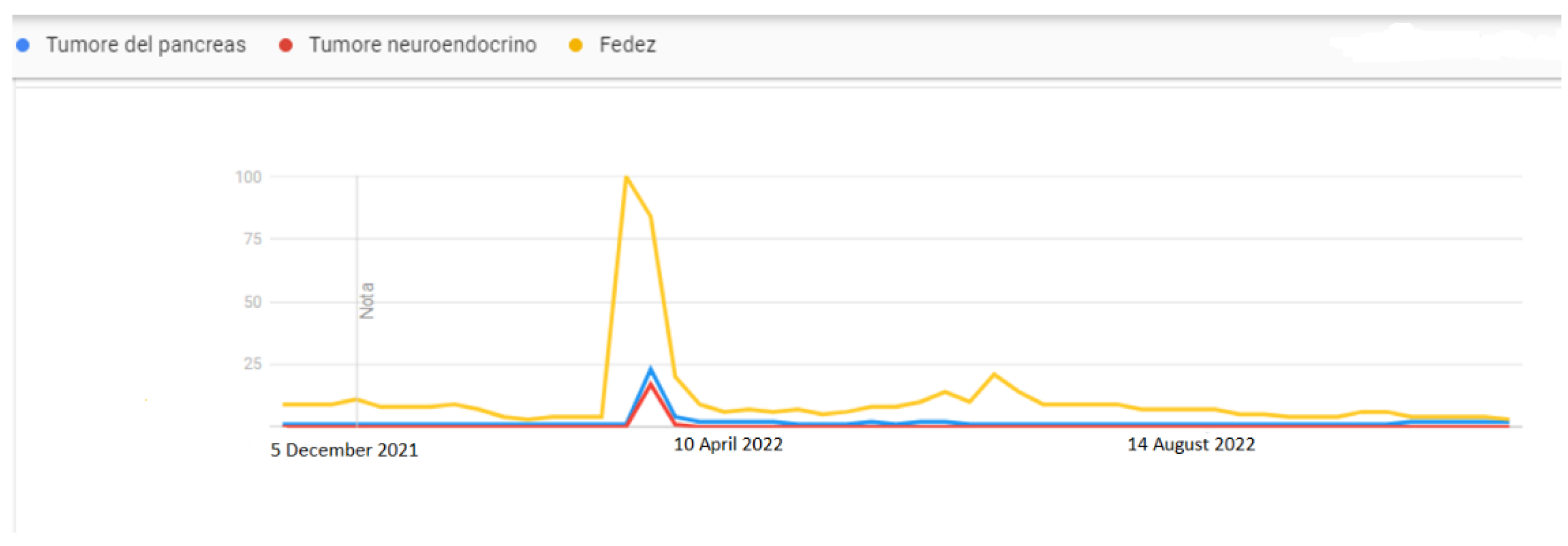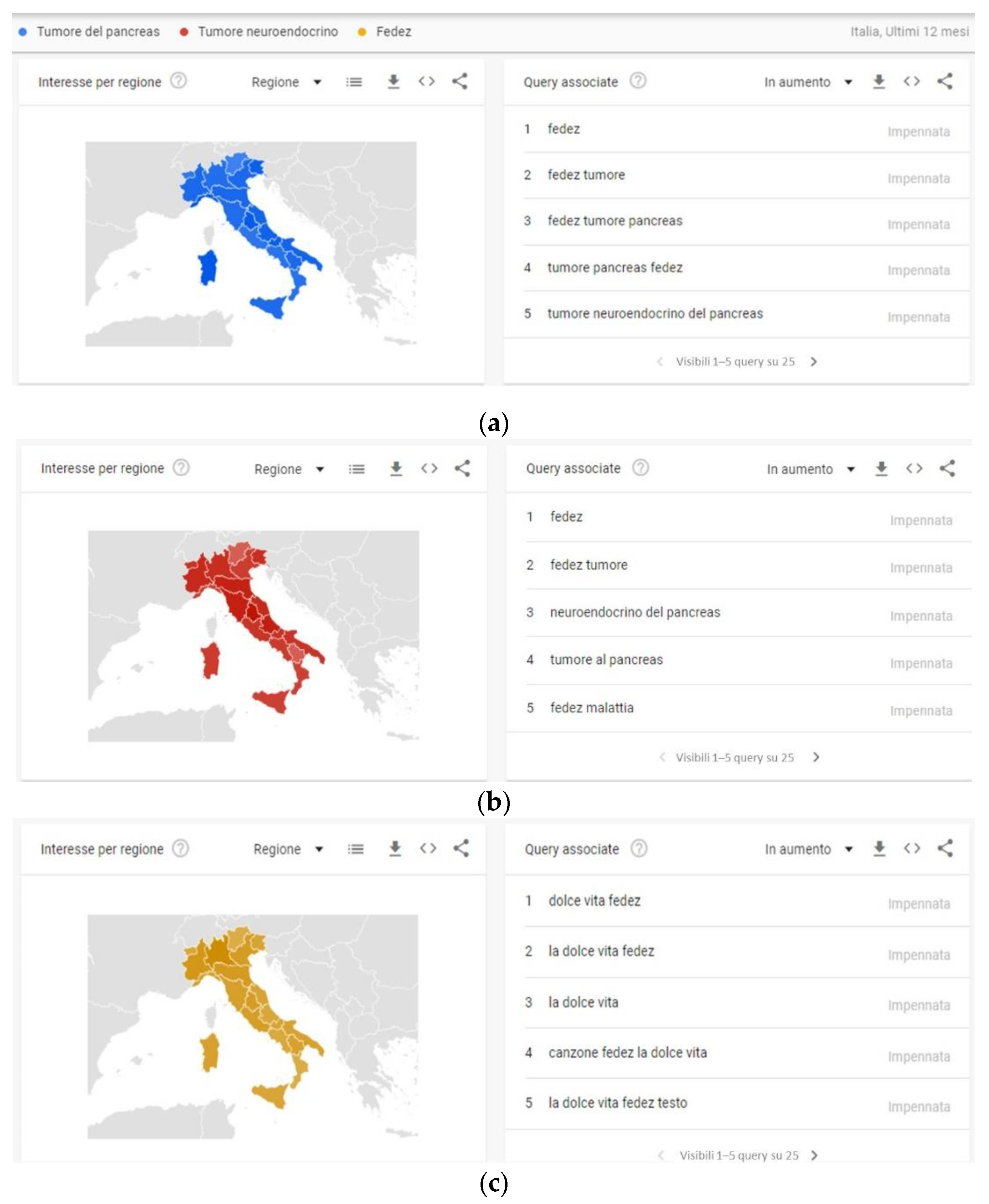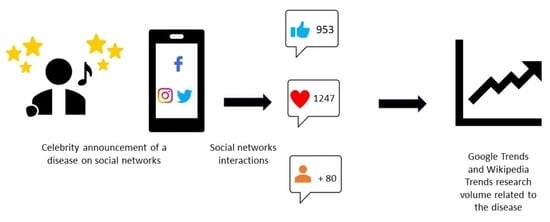Using Google Trends and Wikipedia to Investigate the Global Public’s Interest in the Pancreatic Cancer Diagnosis of a Celebrity
Abstract
1. Introduction
2. Materials and Methods
3. Results
4. Discussion
4.1. Implications for Public Health Policies and Practice
4.2. Strengths and Limitations
5. Conclusions
Author Contributions
Funding
Institutional Review Board Statement
Informed Consent Statement
Data Availability Statement
Acknowledgments
Conflicts of Interest
References
- American Cancer Society. Cancer Facts & Figures 2022. American Cancer Society, Atlanta. 2022. Available online: https://www.cancer.org/content/dam/cancer-org/research/cancer-facts-and-statistics/annual-cancer-facts-and-figures/2022/2022-cancer-facts-and-figures.pdf (accessed on 3 December 2022).
- Kommalapati, A.; Tella, S.H.; Goyal, G.; Ma, W.W.; Mahipal, A. Contemporary Management of Localized Resectable Pancreatic Cancer. Cancers 2018, 10, 24. [Google Scholar] [CrossRef] [PubMed]
- Siegel, R.L.; Miller, K.D.; Fuchs, H.E.; Jemal, A. Cancer Statistics, 2021. CA Cancer J. Clin. 2021, 71, 7–33. [Google Scholar] [CrossRef] [PubMed]
- GBD2017 Pancreatic Cancer Collaborators. The global, regional, and national burden of pancreatic cancer and its attributable risk factors in 195 countries and territories, 1990–2017: A systematic analysis for the Global Burden of Disease Study 2017. Lancet Gastroenterol. Hepatol. 2019, 4, 934–947. [Google Scholar] [CrossRef]
- Rahib, L.; Smith, B.D.; Aizenberg, R.; Rosenzweig, A.B.; Fleshman, J.M.; Matrisian, L.M. Projecting cancer incidence and deaths to 2030: The unexpected burden of thyroid, liver, and pancreas cancers in the United States. Cancer Res. 2014, 74, 2913–2921. [Google Scholar] [CrossRef] [PubMed]
- Cao, D.; Song, Q.; Li, J.; Jiang, Y.; Wang, Z.; Lu, S. Opportunities and challenges in targeted therapy and immunotherapy for pancreatic cancer. Expert Rev. Mol. Med. 2021, 23, E21. [Google Scholar] [CrossRef]
- Hernandez, D.; Wagner, F.; Hernandez-Villafuerte, K.; Schlander, M. Economic Burden of Pancreatic Cancer in Europe: A Literature Review. J. Gastrointest. Cancer 2022, 26, 1–17. [Google Scholar] [CrossRef]
- Chua, G.P.; Tan, H.K.; Gandhi, M. What information do cancer patients want and how well are their needs being met? Ecancermedicalscience 2018, 12, 873. [Google Scholar] [CrossRef]
- Gianfredi, V.; Santangelo, O.E.; Provenzano, S. Correlation between flu and Wikipedia’s pages visualization. Acta Biomed 2021, 92, e2021056. [Google Scholar] [CrossRef]
- Provenzano, S.; Gianfredi, V.; Santangelo, O.E. Insight the data: Wikipedia’s researches and real cases of arboviruses in Italy. Public Health 2021, 192, 21–29. [Google Scholar] [CrossRef]
- Santangelo, O.E.; Provenzano, S.; Gianfredi, V. Infodemiology of flu: Google trends-based analysis of Italians’ digital behavior and a focus on SARS-CoV-2, Italy. J. Prev. Med. Hyg. 2021, 62, E586–E591. [Google Scholar] [CrossRef]
- Santangelo, O.E.; Gianfredi, V.; Provenzano, S. Wikipedia searches and the epidemiology of infectious diseases: A systematic review. Data Knowl. Eng. 2022, 142, 102093. [Google Scholar] [CrossRef]
- Santangelo, O.E.; Grigis, D.; Giordano, D.; Armetta, F.; Firenze, A. Can Google Trends and Wikipedia help traditional surveillance? A pilot study on measles. Acta Biomed 2020, 91, e2020190. [Google Scholar] [CrossRef] [PubMed]
- Gianfredi, V.; Provenzano, S.; Santangelo, O.E. What can internet users’ behaviours reveal about the mental health impacts of the COVID-19 pandemic? A systematic review. Public Health 2021, 198, 44–52. [Google Scholar] [CrossRef] [PubMed]
- Google Trends. Explore What the World is Searching. Google, United States. 2022. Available online: https://trends.google.it/trends/?geo=IT (accessed on 2 December 2022).
- Wikipedia. Analysis of Page Views. Wikipedia, United States. 2022. Available online: https://tools.wmflabs.org/pageviews (accessed on 2 December 2022).
- Kaleem, T.; Malouff, T.D.; Stross, W.C.; Waddle, M.R.; Miller, D.H.; Seymour, A.L.; Zaorsky, N.G.; Miller, R.C.; Trifiletti, D.M.; Vallow, L. Google Search Trends in Oncology and the Impact of Celebrity Cancer Awareness. Cureus 2019, 11, e5360. [Google Scholar] [CrossRef] [PubMed]
- Ayers, J.W.; Althouse, B.M.; Noar, S.M.; Cohen, J.E. Do celebrity cancer diagnoses promote primary cancer prevention? Prev. Med. 2014, 58, 81–84. [Google Scholar] [CrossRef]
- Mukaka, M.M. Statistics corner: A guide to appropriate use of correlation coefficient in medical research. Malawi Med. J. 2012, 24, 69–71. [Google Scholar]
- Metcalfe, D.; Price, C.; Powell, J. Media coverage and public reaction to a celebrity cancer diagnosis. J. Public Health 2010, 33, 80–85. [Google Scholar] [CrossRef] [PubMed]
- Naik, H.; Johnson, M.D.D.; Johnson, M.R. Internet Interest in Colon Cancer Following the Death of Chadwick Boseman: Infoveillance Study. J. Med. Internet. Res. 2021, 23, e27052. [Google Scholar] [CrossRef]
- StataCorp. Stata Statistical Software, version 14; StataCorp LLC: College Station, TX, USA, 2015. [Google Scholar]
- Noar, S.M.; Ribisl, K.; Althouse, B.M.; Willoughby, J.; Ayers, J.W. Using Digital Surveillance to Examine the Impact of Public Figure Pancreatic Cancer Announcements on Media and Search Query Outcomes. JNCI Monogr. 2013, 2013, 188–194. [Google Scholar] [CrossRef]
- Foroughi, F.; Lam, A.K.-Y.; Lim, M.S.; Saremi, N.; Ahmadvand, A.; Zeng, D.; Neto, O.L.; Mackey, T.; Ginossar, T.; Dreyer, N.; et al. “Googling” for Cancer: An Infodemiological Assessment of Online Search Interests in Australia, Canada, New Zealand, the United Kingdom, and the United States. JMIR Cancer 2016, 2, e5. [Google Scholar] [CrossRef]
- Gianfredi, V.; Bragazzi, N.L.; Nucci, D.; Martini, M.; Rosselli, R.; Minelli, L.; Moretti, M. Harnessing Big Data for Communicable Tropical and Sub-Tropical Disorders: Implications from a Systematic Review of the Literature. Front. Public Health 2018, 6, 90. [Google Scholar] [CrossRef] [PubMed]
- Gianfredi, V.; Bragazzi, N.; Mahamid, M.; Bisharat, B.; Mahroum, N.; Amital, H.; Adawi, M. Monitoring public interest toward pertussis outbreaks: An extensive Google Trends–based analysis. Public Health 2018, 165, 9–15. [Google Scholar] [CrossRef] [PubMed]
- Mahroum, N.; Bragazzi, N.L.; Sharif, K.; Gianfredi, V.; Nucci, D.; Rosselli, R.; Brigo, F.; Adawi, M.; Amital, H.; Watad, A. Leveraging Google Trends, Twitter, and Wikipedia to Investigate the Impact of a Celebrityʼs Death from Rheumatoid Arthritis. Am. J. Clin. Oncol. 2018, 24, 188–192. [Google Scholar] [CrossRef] [PubMed]
- Nucci, D.; Santangelo, O.E.; Nardi, M.; Provenzano, S.; Gianfredi, V. Wikipedia, Google Trends and Diet: Assessment of Temporal Trends in the Internet Users’ Searches in Italy before and during COVID-19 Pandemic. Nutrients 2021, 13, 3683. [Google Scholar] [CrossRef]
- Bragazzi, N.L.; Barberis, I.; Rosselli, R.; Gianfredi, V.; Nucci, D.; Moretti, M.; Salvatori, T.; Martucci, G.; Martini, M. How often people google for vaccination: Qualitative and quantitative insights from a systematic search of the web-based activities using Google Trends. Hum. Vaccines Immunother. 2016, 13, 464–469. [Google Scholar] [CrossRef]
- Bragazzi, N.L.; Gianfredi, V.; Villarini, M.; Rosselli, R.; Nasr, A.; Hussein, A.; Martini, M.; Behzadifar, M. Vaccines Meet Big Data: State-of-the-Art and Future Prospects. From the Classical 3Is (“Isolate–Inactivate–Inject”) Vaccinology 1.0 to Vaccinology 3.0, Vaccinomics, and Beyond: A Historical Overview. Front. Public Health 2018, 6, 62. [Google Scholar] [CrossRef]
- Zhang, Z.; Zheng, X.; Zeng, D.D.; Leischow, S.J. Information Seeking Regarding Tobacco and Lung Cancer: Effects of Seasonality. PLoS ONE 2015, 10, e0117938. [Google Scholar] [CrossRef]
- Bloom, R.; Amber, K.T.; Hu, S.; Kirsner, R. Google Search Trends and Skin Cancer. JAMA Dermatol. 2015, 151, 903–905. [Google Scholar] [CrossRef] [PubMed]
- Murray, G.; O’Rourke, C.; Hogan, J.; Fenton, J. Detecting internet search activity for mouth cancer in Ireland. Br. J. Oral Maxillofac. Surg. 2016, 54, 163–165. [Google Scholar] [CrossRef] [PubMed]
- Gianfredi, V.; Grisci, C.; Nucci, D.; Parisi, V.; Moretti, M. Communication in health. Recenti. Prog. Med. 2018, 109, 374–383. [Google Scholar] [CrossRef]
- Gianfredi, V.; Odone, A.; Fiacchini, D.; Rosselli, R.; Battista, T.; Signorelli, C. Trust and reputation management, branding, social media management nelle organizzazioni sanitarie: Sfide e opportunità per la comunità igienistica italiana. J. Prev. Med. Hyg. 2019, 60, E108–E109. [Google Scholar]
- Gianfredi, V.; Balzarini, F.; Gola, M.; Mangano, S.; Carpagnano, L.F.; Colucci, M.E.; Gentile, L.; Piscitelli, A.; Quattrone, F.; Scuri, S.; et al. Leadership in Public Health: Opportunities for Young Generations Within Scientific Associations and the Experience of the “Academy of Young Leaders”. Front. Public Health 2019, 7, 378. [Google Scholar] [CrossRef] [PubMed]
- Malik, S. A Comparative Study of two major Search Engines: Google and Yahoo. Orient. J. Comput. Sci. Technol. 2014, 7, 29–37. [Google Scholar]



| Fedez_GT | Tumore del Pancreas_GT (Pancreatic Cancer in GT) | Tumore Neuroendocrino_GT (Neuroendocrine Tumor in GT) | ||
|---|---|---|---|---|
| Fedez_GT | r | 1 | ||
| p-value | - | |||
| Tumore del pancreas_GT (pancreatic cancer in GT) | r | 0.57 | 1 | |
| p-value | <0.001 | - | ||
| Tumore neuroendocrino_GT (neuroendocrine tumor in GT) | r | 0.46 | 0.83 | 1 |
| p-value | <0.001 | <0.001 | - |
| Fedez_Wiki | Tumore del Pancreas_Wiki (Pancreatic Cancer in Wiki) | Tumore Neuroendocrino_Wiki (Neuroendocrine Tumor in Wiki) | ||
|---|---|---|---|---|
| Fedez_Wiki | r | 1 | ||
| - | ||||
| Tumore del pancreas_Wiki (pancreatic cancer in Wiki) | r | 0.19 | 1 | |
| p-value | 0.07 | - | ||
| Tumore euroendocrine_Wiki (neuroendocrine tumor in Wiki) | r | 0.06 | 0.37 | 1 |
| p-value | 0.60 | <0.001 | - |
| Fedez_GT | Tumore del Pancreas_GT (Pancreatic Cancer in GT) | Tumore Neuroendocrino_GT (Neuroendocrine Tumor in GT) | ||
|---|---|---|---|---|
| Fedez_GT | r | 1 | ||
| p-value | - | |||
| Tumore del pancreas_GT (pancreatic cancer in GT) | r | 0.61 | 1 | |
| p-value | <0.001 | - | ||
| Tumore neuroendocrino_GT (neuroendocrine tumor in GT) | r | 0.62 | 0.99 | 1 |
| p-value | <0.001 | <0.001 | - |
| Fedez_Wiki | Tumore del Pancreas_Wiki (Pancreatic Cancer in Wiki) | Tumore Neuroendocrino_Wiki (Neuroendocrine Tumor in Wiki) | ||
|---|---|---|---|---|
| Fedez_Wiki | r | 1 | ||
| p-value | - | |||
| Tumore del pancreas_Wiki (pancreatic cancer in Wiki) | r | 0.193 | 1 | |
| p-value | <0.001 | - | ||
| Tumore neuroendocrino_Wiki (neuroendocrine tumor in Wiki) | r | 0.12 | 0.65 | 1 |
| p-value | 0.019 | <0.001 | - |
Disclaimer/Publisher’s Note: The statements, opinions and data contained in all publications are solely those of the individual author(s) and contributor(s) and not of MDPI and/or the editor(s). MDPI and/or the editor(s) disclaim responsibility for any injury to people or property resulting from any ideas, methods, instructions or products referred to in the content. |
© 2023 by the authors. Licensee MDPI, Basel, Switzerland. This article is an open access article distributed under the terms and conditions of the Creative Commons Attribution (CC BY) license (https://creativecommons.org/licenses/by/4.0/).
Share and Cite
Gianfredi, V.; Nucci, D.; Nardi, M.; Santangelo, O.E.; Provenzano, S. Using Google Trends and Wikipedia to Investigate the Global Public’s Interest in the Pancreatic Cancer Diagnosis of a Celebrity. Int. J. Environ. Res. Public Health 2023, 20, 2106. https://doi.org/10.3390/ijerph20032106
Gianfredi V, Nucci D, Nardi M, Santangelo OE, Provenzano S. Using Google Trends and Wikipedia to Investigate the Global Public’s Interest in the Pancreatic Cancer Diagnosis of a Celebrity. International Journal of Environmental Research and Public Health. 2023; 20(3):2106. https://doi.org/10.3390/ijerph20032106
Chicago/Turabian StyleGianfredi, Vincenza, Daniele Nucci, Mariateresa Nardi, Omar Enzo Santangelo, and Sandro Provenzano. 2023. "Using Google Trends and Wikipedia to Investigate the Global Public’s Interest in the Pancreatic Cancer Diagnosis of a Celebrity" International Journal of Environmental Research and Public Health 20, no. 3: 2106. https://doi.org/10.3390/ijerph20032106
APA StyleGianfredi, V., Nucci, D., Nardi, M., Santangelo, O. E., & Provenzano, S. (2023). Using Google Trends and Wikipedia to Investigate the Global Public’s Interest in the Pancreatic Cancer Diagnosis of a Celebrity. International Journal of Environmental Research and Public Health, 20(3), 2106. https://doi.org/10.3390/ijerph20032106








